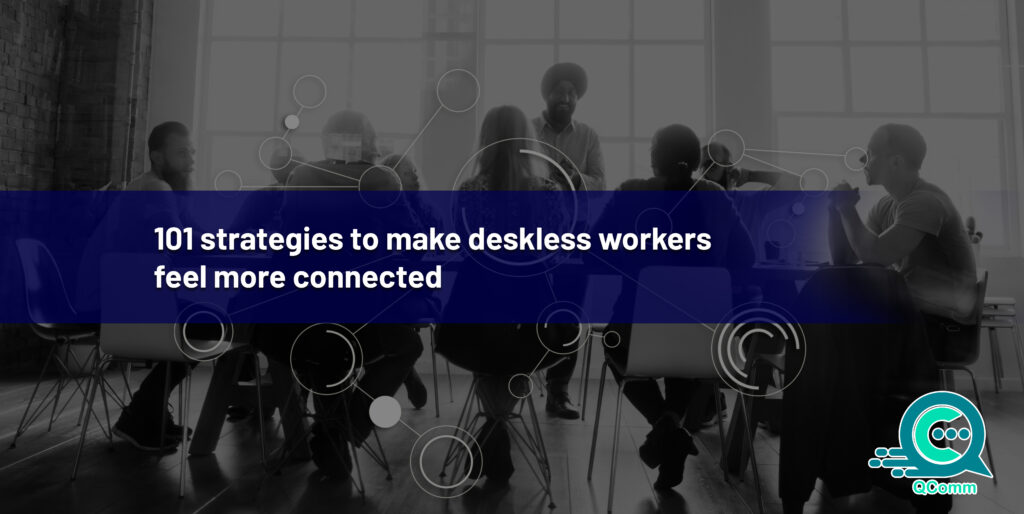
Did you know that over 80% of the global workforce consists of deskless workers?
That’s right, a vast majority of employees perform their jobs outside of a traditional office setting. From delivery individuals to construction workers and field technicians, these individuals are the backbone of countless industries.
However, the physical separation from a central office can lead to feelings of isolation and disconnection for deskless employees. This can negatively impact morale, engagement, and ultimately job satisfaction.
Here’s the good news: there are numerous strategies that companies can implement to bridge the physical gap and foster a sense of belonging and connection for their deskless workforce.
Keep reading the guide to explore the unique needs of deskless workers, the challenges they face, and a plethora of strategies to make them feel like valued members of the team.
Common Challenges Deskless Employees Face:
While deskless jobs offer a degree of autonomy and flexibility, the physical separation from the office can present unique challenges. Here are some of the most common issues deskless workers encounter:
Difficulties With Recognition & Appreciation
The contribution of deskless workers can sometimes go unnoticed compared to their office-based counterparts. A recent study by McKinsey & Company found that deskless workers are less likely to feel their contributions are valued compared to office workers. This lack of recognition can negatively impact morale and motivation.
Feeling Of Isolation
Working away from colleagues can lead to feelings of loneliness and detachment from the company culture. According to a 2022 study by Boston Consulting Group, it was found out that 53% of deskless workers feel burned out at work, and more than four out of ten are at risk of quitting, partly due to feelings of isolation.
Lack Of Information Flow
Deskless employees may struggle to stay informed about company news, updates, and announcements. According to a 2020 survey by Nudge, 59% of deskless workers feel that the communications they receive are inadequate. This lack of information can lead to confusion, frustration, and a sense of being out of the loop.
Feeling Unsafe
Certain deskless roles may involve working in potentially hazardous environments or alone, leading to safety concerns. Deskless workers in industries like construction, transportation, and healthcare, are more susceptible to accidents and injuries.
Here are some additional challenges faced by deskless workers:
- Scheduling Issues
Many deskless industries rely on shift work, which can disrupt work-life balance and make it difficult to plan personal activities.
- Limited Technological Resources
Deskless workers may not have access to the same technology tools as their office-based counterparts, hindering communication and productivity.
- Career Development Concerns
Deskless workers might feel limited in their career advancement opportunities due to the perception that their rules lack upward mobility.
Companies must develop strategies to bridge the gap and create a more connected and engaged deskless workforce.
Common Strategies For Making Deskless Workers Feel Connected
Fortunately, there are numerous strategies for creating a sense of inclusivity among deskless employees. Here are some of the key tips:
Communication Is Key:
Regular Communication
Implement routine communication channels to keep deskless workers informed. 84% of deskless workers say they don’t get enough direct communication from top management according to a study by Ragan Communications.
Use a combination of methods that cater to different preferences, such as:
- Company Newsletters
- Email Updates
- Internal Social Media Platforms
Employee Communications Software
Make sure to invest in employee communications software specifically designed to reach deskless workers. These platforms often include features like:
- Instant Messaging
- Push Notifications
- Message Boards
A 2021 survey by Walkie Talkie found that 72% of deskless workers reported feeling more engaged when they have access to a platform for real-time communication with colleagues.
Mass Notification Systems
Ensure effective emergency communication systems are in place to alert deskless workers of critical situations or safety hazards. Utilize mass notification software that allows for sending real-time alerts via:
- Text Message
- Voice Calls
Mobile Learning Apps
Provide bite-sized training modules and microlearning opportunities accessible on smartphones and tablets. These apps can:
- Track Learner Progress
- Offer Gamification Features
- Work Offline
Video Conferencing Tools
Facilitate virtual meetings, team huddles, and remote onboarding with features like:
- High-Definition Video And Audio
- Screen Sharing And Collaboration Tools
- Meeting Recording Capabilities
Building A Sense Of Community
Virtual Team Meetings
Schedule regular virtual team meetings to allow deskless workers to connect with colleagues, discuss projects, and share ideas. A 2023 report by Trello found that 77% of deskless workers felt more connected to their team when they participated in regular virtual meetings.
However, keep these meetings focused and efficient to avoid discussions and encourage active participation from deskless workers.
Employee Recognition Programs
Implement programs that acknowledge and celebrate the achievements of deskless workers. A study by Achievers found that companies with strong programs experience 31% lower voluntary turnover.
Here are some recognition strategies:
- Public Recognition in Company Communications
- Bonus Structures
- Team-Based Incentives
Social Events
Organize social events specifically for deskless workers or create opportunities for them to connect with office-based colleagues outside of work hours.
These events could include:
- Team-Building Outings
- Virtual Happy Hours
- Volunteer Days
Fostering Training And Development
Microlearning Programs
Provide bite-sized training modules accessible through mobile devices to promote continuous learning and development for deskless workers. A 2022 report by LinkedIn found that 71% of deskless workers reported a preference for microlearning modules due to their flexibility and ease of access.
These modules can cover a wide range of topics, from job-specific skills to soft skills development.
Online Training Courses
Utilize online training platforms to offer comprehensive training programs that deskless workers can access on their own time. Did you know, 68% of deskless workers reported feeling more confident in their roles when they have access to online training.
Supporting Wellbeing and Safety:
Employee Assistance Programs
Provide access to confidential EAPs for deskless workers to receive support with personal or work-related challenges.
Safety Training And Resources
Ensure all deskless workers receive comprehensive safety training specific to their job roles and provide them with readily accessible safety resources.
Wellness Programs
Offer wellness programs that cater to the unique needs of deskless workers, such as on-demand fitness classes or stress management resources.
By implementing these strategies, companies can foster a more connected and engaged deskless workforce, ultimately leading to a more productive and successful organization.


